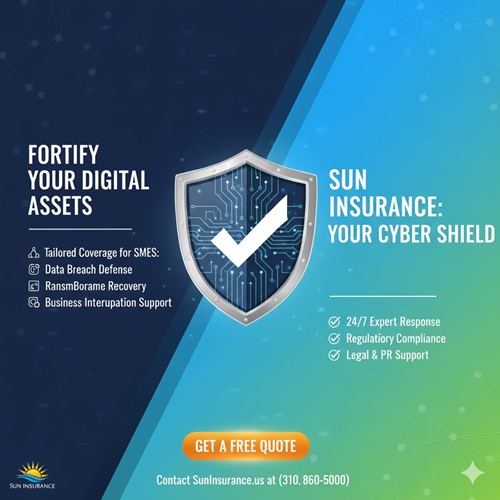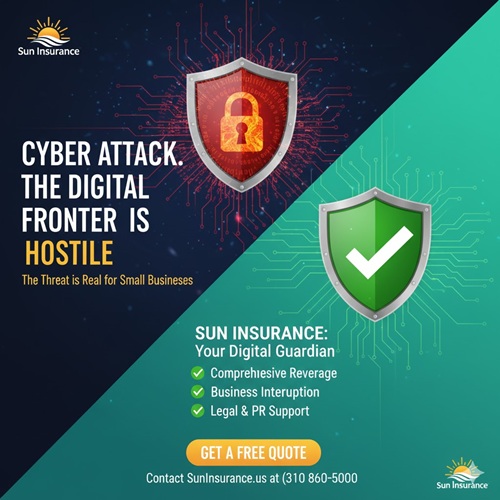Cyber Insurance for Small Businesses: The promise of the digital age is incredible: unprecedented access to global markets, efficient operations, and powerful cloud tools. Yet, with this promise comes a profound peril. The interconnected world has expanded the threat surface, making small and medium-sized enterprises (SMEs) the most frequent targets of cyberattacks. While large corporations capture headlines, it is the SME, often lacking the budgets for sophisticated, 24/7 cybersecurity teams, that becomes the vulnerable entry point. This reality makes securing dedicated Cyber Insurance for Small Businesses not merely a precautionary measure—it is the single most critical cornerstone of modern financial risk management.
Ignoring this risk is akin to opening a physical store without fire insurance. The data you hold—from customer credit card details and proprietary secrets to employee records—is your most valuable asset, and consequently, the hacker’s primary target. A successful attack can trigger a chain reaction of financial, legal, and reputational disasters. Therefore, understanding and obtaining robust Cyber Insurance for Small Businesses is essential to ensuring organizational resilience and long-term viability.
📝 Table of Contents
- The Escalating Threat: Why Small Businesses Are Prime Targets
- Defining Cyber Insurance: Differentiating It from Standard Policies
- Core Coverage Explained: What Does Cyber Insurance for Small Businesses Cover?
- First-Party Costs (Direct Expenses)
- Third-Party Liability (Claims Against You)
- Who Needs It? The Universal Requirement for Digital Operations
- Detailed Comparison: Cyber vs. Other Liability Policies
- Crucial Policy Deep Dive: Key Exclusions to Watch For
- The Vetting Process: Choosing the Right Cyber Liability Policy
- Scenarios & Outcomes: Real-World Cyber Insurance in Action (Case Studies)
- FAQ: Answering Your Questions about Data Breach Insurance
- Securing Your Future: Next Steps
🚨 1. The Escalating Threat: Why Small Businesses Are Prime Targets

The statistics are grim: reports consistently show that over 60% of small businesses targeted by a significant cyberattack go out of business within six months. This staggering failure rate is a direct result of the unbudgeted, catastrophic costs associated with recovery. Cybercriminals operate on a simple principle: efficiency. They know that while major enterprises may have dedicated security teams and millions to spend on defenses, small businesses often rely on basic antivirus software, single-factor authentication, and infrequent employee training.
SMEs are viewed as “soft targets” for several reasons:
- Vulnerable Supply Chain Links: Attackers often target a small vendor with weak security as a pivot point to compromise a larger, better-protected client—a tactic known as a supply chain attack.
- Data Density: Small businesses still handle the same high-value data types—PII (Personally Identifiable Information), HIPAA-protected PHI (Protected Health Information), and financial records—but with fewer protections.
- Attack Diversity: The attacks are no longer just sophisticated, targeted hacks. They include high-volume, automated attacks like:
- Ransomware: Encrypting systems and demanding payment, often crippling operational technology (OT) or point-of-sale (POS) systems.
- Phishing and Social Engineering: Manipulating employees into revealing credentials or initiating fraudulent wire transfers (Business Email Compromise, or BEC).
- Credential Stuffing: Using lists of stolen usernames and passwords from other breaches to test logins on your systems.
When an attack lands, the financial consequences are immediate and paralyzing. The cost isn’t just the ransom; it includes legal fees, forensic investigations, and regulatory fines—a burden that far outstrips the typical small business reserve fund. The existence of robust Cyber Insurance for Small Businesses is the only reliable financial mechanism to transfer this risk.
❓ 2. Defining Cyber Insurance: Differentiating It from Standard Policies

Cyber insurance (alternatively known as cyber liability insurance, cyber security insurance, or data breach insurance) is a specialized, modern policy crafted specifically to address risks arising from the use of technology and the digital handling of data.
The Problem of “Silent Cyber” and Coverage Gaps
Many small business owners operate under the dangerous misconception that their general insurance portfolio will protect them. This idea, known as “silent cyber,” is rapidly being clarified by the insurance industry.
| Policy Type | Primary Focus | Cyber Incident Coverage | Limitation and Exclusion |
| Commercial General Liability (CGL) | Covers bodily injury, property damage, and advertising injury. | No Digital Coverage. Courts have ruled that “property damage” generally refers to tangible assets, not digital data or networks. | Excludes: Data loss, regulatory fines, system restoration, forensic costs, and business interruption from a cyber event. |
| Business Owner’s Policy (BOP) | Bundles CGL, business property, and business interruption from physical perils (fire, theft, etc.). | Extremely Limited. May cover physical damage to a server if it was damaged in a lightning strike, but not the data on the server. | Excludes: Ransom payments, customer notification costs, third-party liability claims, and cyber extortion. |
| Professional Liability (E&O) | Covers claims of financial harm resulting from professional errors or negligence in service delivery. | Limited Coverage. May cover claims if a software malfunction caused client financial loss, but typically not network security failure leading to a hack. | Excludes: First-party expenses like incident response, ransomware costs, and network restoration. |
| Cyber Insurance | Covers financial loss from network security failures, data breaches, system outages, and resulting regulatory and legal costs. | Comprehensive Coverage. Specifically and explicitly designed to respond to digital risks. | Minimal exclusions tied to specific events (e.g., acts of war). |
This clear distinction shows why dedicated Cyber Insurance for Small Businesses is not a redundant expense; it fills a massive, existential gap in your financial protection.
💰 3. Core Coverage Explained: What Does Cyber Insurance for Small Businesses Cover?

A comprehensive cyber liability insurance policy structure is crucial to recovery. It must address both the immediate costs you incur and the long-term liabilities placed upon you by third parties.
A. First-Party Costs (Direct Expenses Incurred by Your Business)
These costs are about triage and recovery—getting your business back online and compliant. Sub-limits often apply here, meaning the total policy limit is split among these categories.
- Incident Response and Computer Forensics 🕵️: The most vital and immediate expense. The policy pays for specialized third-party experts to:
- Determine the scope, cause, and duration of the breach.
- Contain the intrusion and stop data exfiltration.
- Identify compromised data subjects (key for notification).
- Data Restoration and System Repair 💾: Covers the expense of rebuilding corrupted systems, replacing or patching software, and restoring data from backups. This is critical if the attack rendered systems unusable or backups were also compromised.
- Business Interruption (BI) 🛑: Pays for the net profits lost and extra expenses incurred when a covered cyber event (like a ransomware attack or DDoS) forces your network to shut down or operate inefficiently. Policies often include “dependent business interruption” for revenue lost if a critical vendor (like your cloud provider) is hacked.
- Cyber Extortion and Ransomware Payments 💸: Covers the funds paid to the attackers (the ransom) and, equally important, the fees for professional negotiators and cryptocurrency experts who manage the payment process, ensuring regulatory compliance and maximizing the chance of key recovery.
- Crisis Management and Notification Costs 📢: Covers the substantial costs related to legally required customer notification, setting up a dedicated call center, and offering affected customers (data subjects) a year or more of credit monitoring and identity protection services. This also covers public relations specialists hired to manage your reputation during a crisis.
B. Third-Party Liability (Claims Brought Against Your Business)
These costs represent the financial fallout from your alleged failure to protect data entrusted to you.
- Defense and Settlement Costs: Covers the legal defense fees, settlements, and judgments arising from lawsuits filed by affected customers, business partners, or employees whose data was compromised.
- Regulatory Fines and Penalties 🏛️: Crucial coverage for fines imposed by governmental or regulatory bodies (e.g., fines levied by state attorneys general, the FTC, HIPAA, GDPR, or CCPA) due to failure to comply with data protection laws.
- Payment Card Industry (PCI) Fines and Assessments: Specific coverage for fees, fines, and assessment costs levied by banks and credit card brands (Visa, Mastercard, etc.) when an attack compromises payment card data stored or transmitted by your business.
A robust Cyber Insurance for Small Businesses policy is truly an emergency financial fund, legal counsel retainer, and IT recovery budget all wrapped into one essential contract.
🎯 4. Who Needs It? The Universal Requirement for Digital Operations

The misconception that only large e-commerce sites or banks need cyber coverage is dangerous. Any small business that generates revenue or relies on digital systems for operations needs cyber liability insurance.
| Industry | Critical Data Handled | Specific Risk Exposure |
| Healthcare (Clinics, Labs) | PHI (Protected Health Information), Billing Information. | High HIPAA enforcement risk, insider threats, and vulnerability to medical device hacks. |
| Accounting/CPA Firms | Tax IDs, financial statements, bank accounts (e.g., QuickBooks data). | Prime targets for BEC (Business Email Compromise) and wire transfer fraud. |
| Law Firms | Attorney-Client Privilege (ACP) documents, merger/acquisition details. | Highly vulnerable to Espionage and extortion due to confidential case files. |
| Retail & Restaurants | PCI Data, customer loyalty program PII, POS systems. | E-skimming, point-of-sale malware, and DDoS attacks on e-commerce. |
| Real Estate/Title Companies | Escrow funds, closing documents, SSNs, and large transaction wires. | Escrow Fraud and BEC are epidemic, exploiting high-value, time-sensitive wires. |
| Non-Profit Organizations | Donor PII, sensitive constituent data. | Reputational risk is paramount; often targeted due to weak budgets and public donor lists. |
If you own the computers, process the payments, store the data, or rely on a working network to earn revenue, you need the protection offered by Cyber Insurance for Small Businesses.
🗃️ 5. Detailed Comparison: Cyber vs. Other Liability Policies

While the table in Section 2 provided the basic differences, it’s vital to understand the detailed contractual separation between Cyber Liability and Errors & Omissions (E&O) policies, as both are crucial for service-based businesses.
| Feature | Cyber Insurance for Small Businesses | Professional Liability (E&O) |
| Trigger Event | Failure of network security or system availability (a security event). | Failure in the delivery of a professional service (a negligence event). |
| Covered Loss | Financial loss due to data breach, data theft, network downtime, or ransomware. | Financial loss suffered by a client due to a mistake, error, or omission in the advice or service provided by the insured. |
| Example Claim | A hacker bypasses your firewall, steals client data, and you are sued for failing to protect PII. | An architect designs a building with a flaw, or an accountant misses a deadline, causing a client financial harm. |
| Core Value | Risk Transfer (paying costs associated with external malicious action or internal system failure). | Risk Mitigation (covering claims related to the quality of your work). |
In simple terms: E&O protects you when you make a mistake in your job; Cyber Insurance for Small Businesses protects you when a computer system fails or is attacked. Many businesses need both.
🚫 6. Crucial Policy Deep Dive: Key Exclusions to Watch For

Not all cyber liability insurance policies are created equal, and exclusions can be devastating. Small business owners must carefully review these common policy exclusions with their broker:
- Failure to Maintain Security: Policies require the insured to uphold a certain level of security. If the claim stems directly from a failure to implement a basic security measure explicitly required by the policy (like the failure to use Multi-Factor Authentication (MFA) or not patching known critical vulnerabilities), coverage may be denied.
- Future Technological Upgrades: The policy will pay to restore what was there before the attack, but generally will not cover the cost of upgrading your entire network or replacing old infrastructure with new, superior systems.
- “Prior Knowledge” Exclusion: If the insured knew about a specific vulnerability or ongoing issue (e.g., they knew a key server had malware) before the policy inception date, any subsequent breach stemming from that known flaw will likely be excluded.
- Cost of Improving Security: While the policy pays for forensic investigation, it usually excludes the long-term, ongoing expenses associated with improving your internal security posture or hiring permanent staff.
- Infrastructure/Utility Failure: Attacks that stem from a failure of public utilities (like power grid failure) are often excluded, as are claims arising from war, terrorism, or civil unrest.
A skilled broker specializing in Cyber Insurance for Small Businesses is essential to helping you identify these pitfalls and negotiating favorable policy terms.
🧐 7. The Vetting Process: Choosing the Right Cyber Liability Policy

Securing the right data breach insurance requires diligence, as policies vary greatly in terms of covered services and vendor access.
A. Assessing Your Risk Profile
Before applying for Cyber Insurance for Small Businesses, you must know your risk. Underwriters will require details on:
- Data Holdings: What type of data (PII, PHI, PCI) and how many records do you store?
- Security Controls: Do you use MFA, regular backups, encrypted laptops, and strong firewall protection?
- Employee Training: Do employees undergo mandatory annual training on phishing and security awareness?
- Revenue & Industry: This determines the potential severity of a business interruption loss.
B. Understanding Limits and Sub-Limits
Always review the total limit (e.g., $1,000,000) alongside the sub-limits for specific categories. A $1,000,000 policy might only provide a $50,000 sub-limit for forensic costs or a $25,000 sub-limit for regulatory fines. Since forensic investigation and notification costs are immediate and huge, those sub-limits need to be adequate.
C. The Panel of Vendors
One of the greatest benefits of Cyber Insurance for Small Businesses is access to the insurer’s pre-approved panel of expert vendors (legal, forensics, PR). These vendors are specialists who can mobilize immediately. Ensure the policy gives you the flexibility to use the panel, as relying on non-vetted, unspecialized vendors during a crisis can prolong downtime and increase costs dramatically.
⚔️ 8. Scenarios & Outcomes: Real-World Cyber Insurance in Action

These expanded scenarios illustrate the depth of protection provided by a dedicated Cyber Insurance for Small Businesses policy.
Scenario 1: The Ransomware Shutdown (Manufacturing Firm)
- The Incident: A manager clicks a link, installing ransomware that encrypts all the production servers and proprietary CAD files of a small manufacturing firm. The attacker demands $150,000 to release the files.
- The Cyber Policy Response: The policy’s Incident Response coverage immediately sends a forensic team. The Cyber Extortion coverage pays for the negotiator and the $150,000 ransom. The Business Interruption coverage reimburses the firm for $85,000 in lost revenue while the systems were offline for ten days.
- Outcome: The firm is fully operational within two weeks, and the out-of-pocket expense is limited to the deductible.
Scenario 2: The Data Breach (Medical Practice)
- The Incident: A small medical practice discovers an unauthorized user accessed 8,000 patient records containing PHI via a vulnerability in its management software.
- The Cyber Policy Response: The policy’s Third-Party Liability and Regulatory Fines coverage pays for the legal defense against a pending HIPAA investigation. The Notification Costs sub-limit handles $75,000 for patient notification, setting up a call center, and providing credit monitoring services.
- Outcome: The practice navigates the breach with expert legal counsel provided and paid for by the insurer, shielding the owners from devastating regulatory and notification costs.
Scenario 3: The Wire Transfer Fraud (Accounting Firm)
- The Incident: A hacker compromises an accountant’s email (BEC) and successfully directs the owner to wire $95,000 intended for a client tax payment to a fraudulent account.
- The Cyber Policy Response: The policy’s specific Social Engineering/Funds Transfer Fraud extension covers the $95,000 lost. The Defense & Settlement Costs coverage addresses the client’s subsequent lawsuit claiming negligence.
- Outcome: The firm avoids losing a major client and prevents a massive balance sheet hit thanks to the policy’s specialized coverage for non-hacker fraud.
Scenario 4: Escrow Fraud (Real Estate Title Agency)
- The Incident: A title agency’s email system is breached. The attacker sends a spoofed email to a client 24 hours before closing, changing the wiring instructions for the final escrow funds ($\$350,000$). The client wires the money to the attacker’s account.
- The Cyber Policy Response: The Cyber Liability policy steps in, often with a dedicated Third-Party Funds Transfer Fraud endorsement. It covers the legal defense against the client’s lawsuit (who demands the agency return the funds) and potentially the financial loss itself, depending on policy triggers.
- Outcome: The agency is protected from absorbing the $350,000 loss, which would have closed its doors, and receives essential legal defense for the litigation resulting from the high-stakes theft.
🙋 9. FAQ: Answering Your Questions about Data Breach Insurance

| Question | Answer |
| Is it expensive for a small business? | The cost of Cyber Insurance for Small Businesses is generally very reasonable, especially compared to the average cost of a breach (often exceeding $120,000). Premiums are determined by your revenue, industry risk, and implemented security controls (like MFA). |
| What is Multi-Factor Authentication (MFA), and why is it important? | MFA requires two or more verification methods (like a password plus a code from your phone). It is now a mandatory underwriting requirement for most cyber liability insurance policies, as it prevents over 99% of credential theft attacks. |
| Are my employees’ mistakes covered? | Yes. Policies often cover losses resulting from a security failure caused by a negligent or malicious act of an employee, such as clicking a phishing link, misconfiguring a server, or losing a sensitive laptop. This is a critical element of comprehensive Cyber Insurance for Small Businesses. |
| Does the policy cover future lost contracts? | Generally, no. While Business Interruption covers lost revenue during the downtime, it typically does not cover the loss of future, unspecified contracts or the devaluation of goodwill, though the crisis management coverage helps mitigate reputational damage. |
| What happens if my cloud provider (AWS/Google) is hacked? | This is a major concern. Comprehensive policies include Contingent Business Interruption or Dependent Business Interruption coverage, which provides reimbursement if a key vendor or service provider (like your web host or SaaS provider) suffers an outage that prevents you from operating. |
🤝 10. Securing Your Future: Next Steps
The digital threat landscape evolves daily, outpacing the ability of most small businesses to keep up financially. Cyber Insurance for Small Businesses is the indispensable safeguard that transfers this unmanageable risk. It provides not just financial recompense, but immediate access to an elite network of forensic, legal, and public relations experts—resources a small business could never retain alone.
Don’t wait until a headline becomes your reality. Proactively fortify your digital future by securing the right cyber liability insurance.
To understand your specific exposure and tailor a comprehensive policy that ensures business continuity, consult with the specialists at Sun Insurance and Financial.
Telephone: (310) 860-5000
Sun Insurance and Financial https://SunInsurance.us
Travelers Insurance
The Hartford Insurance
California Fair Plan Insurance
Hiscox Insurance

